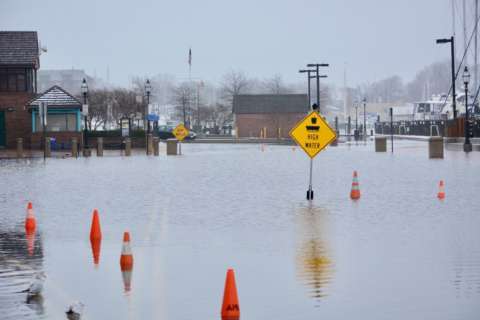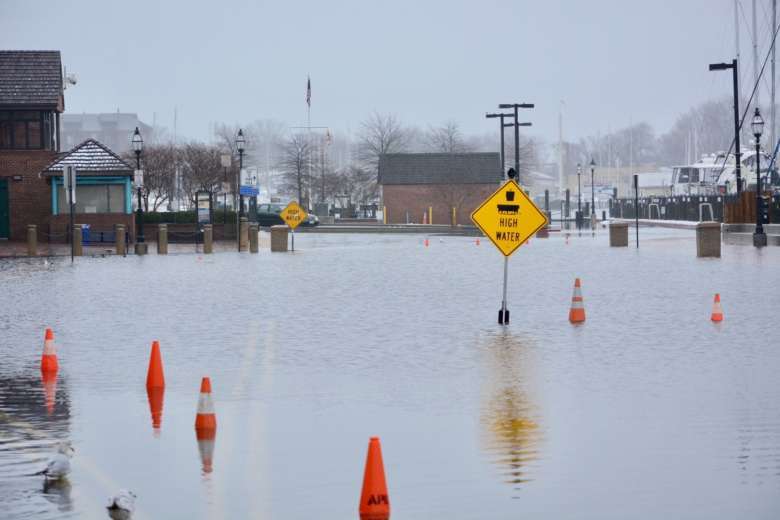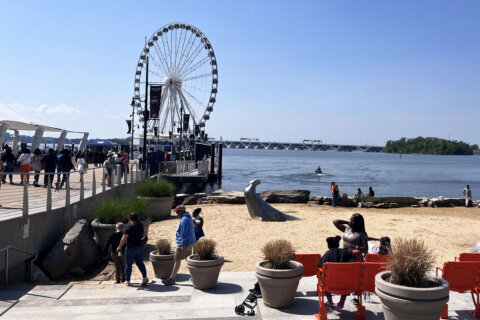This article was republished with permission from WTOP’s news partners at Maryland Matters. Sign up for Maryland Matters’ free email subscription today.

This content was republished with permission from WTOP’s news partners at Maryland Matters. Sign up for Maryland Matters’ free email subscription today.
Even on a pleasant, breezy, partly sunny day in Ocean City, with the waters of Assawoman Bay lapping gently against the pedestrian promenade behind the Roland E. Powell Convention Center, it’s hard not to think about extreme weather. A severe storm, gale-force winds, even sunny day flooding — it wouldn’t take much for the bay water to come lapping up over the barrier and on to the shore, creating havoc in the coastal resort town.
Maryland has experienced 51 days of “severe weather” — excessive heat, high winds, flooding, or some combination — in the past 18 months, according to Anna Sierra, chief development officer of the Maryland Department of Emergency Management.
Sierra and two county emergency management officials who have dealt with some of the state’s biggest recent disasters spoke on a panel Thursday at the Maryland Association of Counties convention about how the state and local governments deal with a range of emergencies. Progress has been made, but undeniable challenges remain, the experts said.
Michael Hinson, director of emergency management in Howard County, where two “thousand-year” floods hit Ellicott City in two years, said the 9/11 terrorist strikes and Hurricane Katrina in 2005 changed the nation’s thinking on emergency preparedness and response — and the pace of change intensified in subsequent years.
“We’re in a different time and place,” Hinson said.
Today, he said, governments deal with a variety of emergencies on a regular basis, from cyberattacks to the opioid crisis, from the failures of aging infrastructure to crime and acts of terrorism, from election security to utility infrastructure to food security.
Then, Hinson said, there’s “the literal and figurative black cloud — climate change.”
“All of these things have been happening, we’ve been expanding what we’ve been doing,” Hinson said. “But we don’t necessarily have more hands to do it with.”
Additionally, emergencies become exponentially more catastrophic, the officials said, and government funding to address them hasn’t kept pace. Federal disaster aid places a lot of strings on how state and local governments can distribute the money.
“We’re being asked to do a lot with essentially less money than we’ve ever had in emergency management,” Sierra said.
The state of Maryland has taken steps to bolster its emergency preparedness and disaster response — but with a major caveat. The General Assembly passed legislation this year, sponsored by Sen. Sarah K. Elfreth (D-Anne Arundel) and Del. Dana Jones (D-Anne Arundel), whose Annapolis-based district has been battered by tornadoes and regular flooding in recent years, to create the State Disaster Recovery Fund, designed to provide resources to residents and businesses in all 24 jurisdictions when a disaster strikes.
The legislation came with the recommendation that the fund be stocked with $20 million annually. But appropriators provided no cash for the 2024 fiscal year.
“There is no legislative mandate to fund the fund,” Sierra observed.
She added that even if it’s fully funded, the pot of money won’t be sufficient to meet all of the state’s needs. As a result, government officials must focus on mitigation.
“Mitigation is now the center of the universe,” Sierra said.
Preeti Emrick, the Anne Arundel County emergency management director, said every disaster requires “a tiered response” involving federal, state and local leaders and resources. But she said local governments are uniquely equipped to confront the “social vulnerabilities” that follow a disaster.
Emrick also suggested that small actions and kindnesses can bolster a community in the immediate aftermath of an emergency — whether it’s delivering a large dumpster to a community, paying for hotels for residents who have been driven from their homes, or supplying essential items like baby formula or kitty litter that residents may not be able to easily obtain.
The important thing, the officials said, is for local leaders to be ready for an infinite number of eventualities and not just respond to catastrophic emergencies.
“The writing is on the wall,” she said. “It is time to be proactive.”








